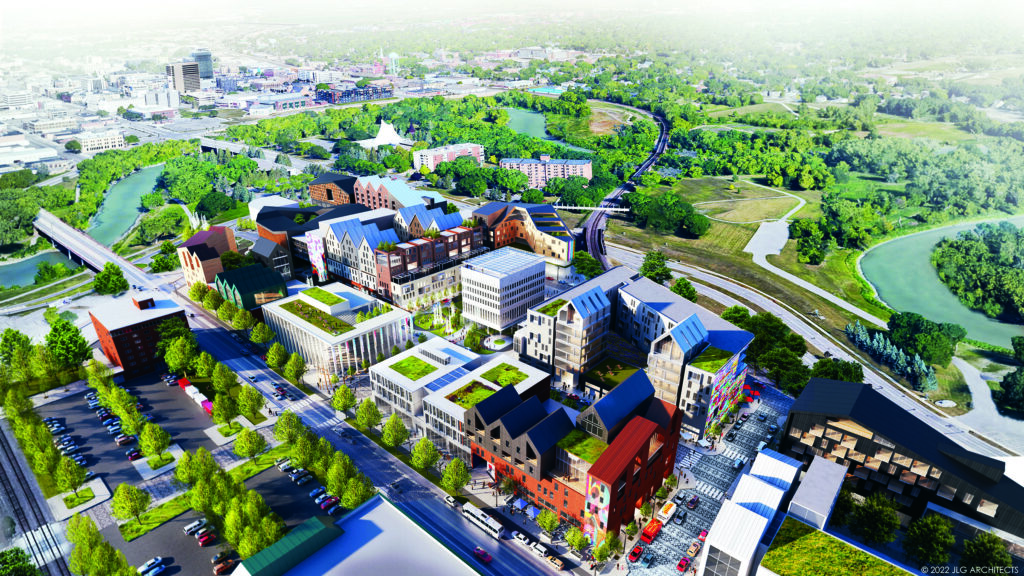
The future of downtown Moorhead includes new commercial and residential buildings where Center Mall now stands. The vision laid out by JLG Architects includes design elements that salute the city’s heritage, along with plenty of outdoor space tying the area to the river that encircles it. (Rendering/JLG Architects.)
It’s the question Moorheaders have long been asking for years: When is something going to happen with the Center Mall?
After five years of study, research and asking residents what they want to see, the city is closer to an answer. Roers Development, the firm it engaged in 2020 to coordinate the next steps, has unveiled a vision for the area now occupied by the fading mall and its ample, empty parking lots – a vision, yes, not a concrete plan … but a framework for what the next five years may bring. Its goal: to restore vibrant life to what city manager Dan Mahli has called “the city’s heart.”
Developer Jim Roers, who heads his namesake construction and development company, laid out the vision his company has developed in collaboration with JLG Architects and the international consulting firm Stantec on Thursday, Aug. 18. Downtown, reimagined, is a densely populated 16 acres where people live, work, shop, relax and enjoy the nearby river. Its theme: “More to Moorhead.”
The downtown he and city leaders sketched out last week, embodied in a colorful architectural rendering of its possibilities, is a lively community in itself that’s a magnet for Moorhead life. Comprised of multi-story mixed-use buildings within a 5-minute walk of the city core, it combines some 1,200 living units – condominiums and apartments – stacked above ground-floor stores and services. Its residents will be able to find everything they need without so much as starting their cars, while plenty of parking invites others into their midst.
The whole area will be “wrapped in the river,” JLG’s Matthew Dunham explained. Mini parks and open spaces within the nine-block complex lead seamlessly to the Red.
“It’s the first time ever we’ll really celebrate living on the river,” Mayor Shelly Carlson points out. With the Fargo Diversion Project limiting its excesses to 37 feet, it will no longer bring periodic destruction, but instead take its place as the centerpiece of a “very Moorhead, very Minnesota” district.
Rob Remark of JLG described how the present 49-year-old mall, with its dim enclosed interior spaces, will be replaced over the next two to five years with walk-up storefronts along Center Avenue. Two low-traffic streets within the 16-acre site will run from the east toward the river. Small parks and plazas will bring a touch of fresh air to welcome strolling visitors and host public arts events through all the four seasons.
Roers’ firm has been working on the future of the downtown district under a “pre-development agreement” it struck with city government. Roers says his group now owns or controls 90 percent of the space and is negotiating for the balance, which includes some of the spaces individually owned by the 11 businesses still operating there.
At the unveiling, Roers conceded that the unusual ownership arrangement under which the Center Mall was built in the early 1970s has complicated the redevelopment process. The mall was the first – and still is one of only a handful – to be developed with store owners themselves holding ownership of the spaces they occupy. The public areas – hallways, restrooms and parking lots – were and still are owned by the city itself, with City Hall the centerpiece of the broad-based one-story structure.
“We’ve been in talks with the remaining businesses. How can we recreate this as a new environment where businesses want to stay?” Roers said. “Now that we’re down to the last 10% of occupants, it’s more difficult, with more issues to resolve.”
At the same time, the Roers group has also been in discussions with four other large Fargo-Moorhead developers. “Three of them have indicated interest in being part of it. They have picked the pieces where they want to work. Like us, they see the value of investment here and the possibilities of the river.”
Development is expected to proceed in phases. The first, focused on the east end of the mall, may break ground in 2023; Kevin Bartram’s Sterling Companies already purchased the former United Sugars building last year for a proposed multi-use commercial and residential structure.
That would be followed by construction of street-facing retail spaces on the south side along Center Avenue, as well as the demolition on the west end once occupied by Herberger’s. The central core of the mall would come last, according to the plan.
One wild card is the proposed convention center and library complex. Moorhead voters will decide in November whether to endorse a city sales tax to fund the center, which would be located in the southwest corner of the area across Center Avenue from US Bank. “When we get a ‘yes’ vote, building the center will be the kindling that lights the flame,” Carlson said. “It will create momentum that helps the whole project move forward much quicker.
“This is going to happen with or without the community center. But approval of the sales tax for the library and center will make it that much easier for the developers to build there. It will be a catalyst for the vision.”
The current taxable value of privately owned property on the 16 acres earmarked for development is $20 million, according to DMI director Derrick LaPoint. The proposed development would eventually boost that taxable valuation to between $200 and $250 million, “turning downtown into a revenue-generating asset for the city,” in his words. Actual investment in the construction would be considerably more, $300 to $350 million.
“Don’t say ‘dream’ when you talk about this,” the mayor cautioned. “This is happening. This is reality!”
More information on the plan, including updates on its status, is available at www.moretomoorhead.com.


